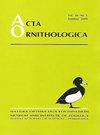普通翠鸟Alcedo的性别比例无季节变化
IF 1.3
4区 生物学
Q3 ORNITHOLOGY
引用次数: 4
摘要
摘要性别分配理论预测,当生育两性的成本/收益可比较时,后代的性别比例是相等的。然而,当养育成本或两性的适应性值不同时,向一个性别倾斜的后代性别比例可能是有益的。在这项研究中,我们分析了Alcedo atthis的普通翠鸟(Common Kingfisher Alcedo atthis)的第二性比(雄性比例),这是一种社会一夫一妻制的物种,每个季节有三到四只雏鸟,由双亲照顾,成年雌性略大于雄性。在2014-2018年期间,在从布拉迪斯拉发到Gabčíkovo(斯洛伐克西南部)的多瑙河系统进行了实地调查。共对78对149窝959只雏鸟进行了性别鉴定,其中雄性483只,雌性476只。我们考虑了以下假设:1)由于研究人口居住在食物丰富的栖息地,性别比例没有季节性变化;2)雌性偏向于在季节早期产卵,因为雌性的快速成熟使它们能够在它们出生的季节繁殖;3)雄性偏向于在繁殖季节的早期产卵,因为一些年轻的雄性已经被记录为巢帮手。然而,仅观察到少数此类病例,因此应谨慎对待。各雏鸟的性别比为0 ~ 1(均为雌性),但雏鸟的平均性别比不偏离胎次。我们没有发现年份、卵量或产蛋日期的影响。因此,我们的结果与其他鸟类研究的结果一致,这些研究发现了平衡的季节性性别比。本文章由计算机程序翻译,如有差异,请以英文原文为准。
No Seasonal Variation of the Sex Ratio in the Common Kingfisher Alcedo atthis Broods
Abstract. Sex allocation theory predicts equal offspring sex ratio when costs/benefits of producing each sex are comparable. However, when costs of rearing or fitness values of sexes vary, skewed offspring sex ratio toward the one sex may be beneficial. In this study we analysed seasonal secondary sex ratio (proportion of males) in broods of the Common Kingfisher Alcedo atthis, the socially monogamous, three- to four-brooded (per season) species with biparental care in which adult females are slightly larger than males. Fieldwork was carried out in the Danube river system from Bratislava to Gabčíkovo (SW Slovakia) during 2014–2018. In total, 959 nestlings from 149 broods of 78 breeding pairs were sexed, amongst which 483 were males and 476 were females. We considered the following assumptions: 1) no seasonal shift in sex ratio, as studied population occupies habitats rich in food; 2) female biased broods early in the season, as females' rapid maturation enables them to breed in the season they have been born; 3) male biased broods early in the season as several young males have been documented to be nest helpers. However, only a few such cases were observed, so it should be treated with caution. The sex ratio of individual broods ranged from 0 (all female) to 1 (all male), but the mean nestling sex ratio did not deviate from parity. We found no effect of year, brood size, or laying date. Thus, our results agree with outcomes of other avian studies where balanced seasonal sex ratio has been found.
求助全文
通过发布文献求助,成功后即可免费获取论文全文。
去求助
来源期刊

Acta Ornithologica
生物-鸟类学
CiteScore
2.10
自引率
0.00%
发文量
14
审稿时长
>12 weeks
期刊介绍:
Publishes scientific papers (original research reports, reviews, short notes, etc.) and announcements from all fields of ornithology. All manuscripts are peer-reviewed.
Established in 1933 as Acta Ornithologica Musei Zoologici Polonici, since 1953 continued under the present title.
Published twice a year by the Natura Optima Dux Foundation under the auspices of the Museum and Institute of Zoology, Polish Academy of Sciences.
 求助内容:
求助内容: 应助结果提醒方式:
应助结果提醒方式:


